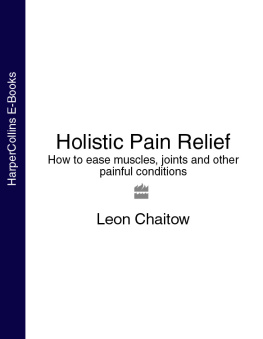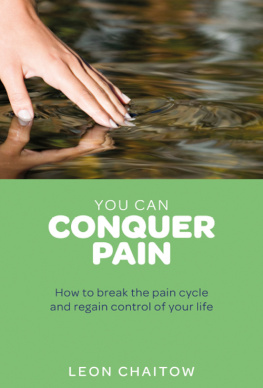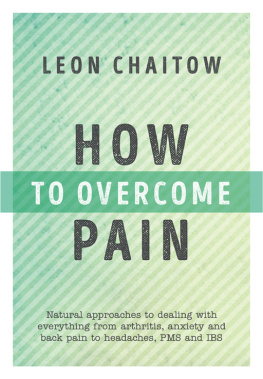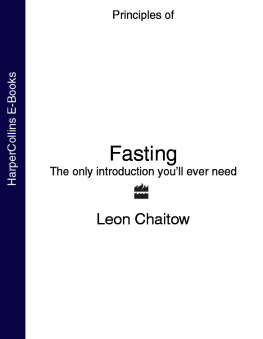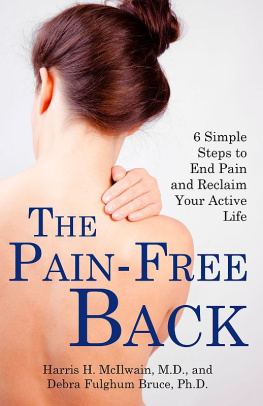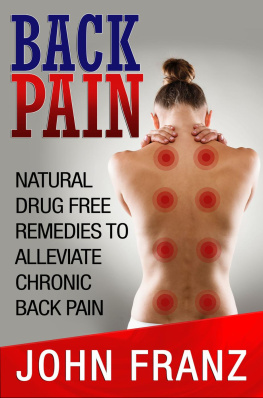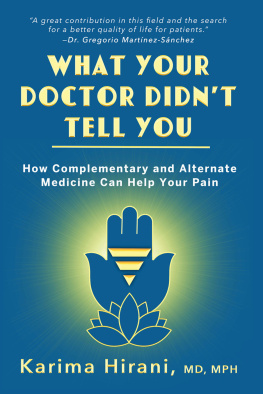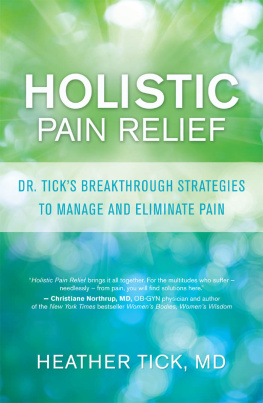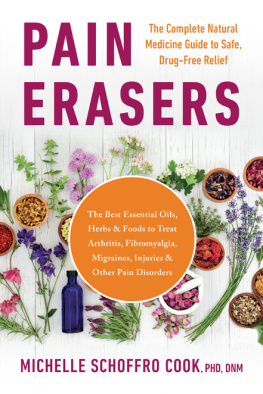Leon Chaitow - Holistic Pain Relief
Here you can read online Leon Chaitow - Holistic Pain Relief full text of the book (entire story) in english for free. Download pdf and epub, get meaning, cover and reviews about this ebook. year: 1997, publisher: Thorsons, genre: Science. Description of the work, (preface) as well as reviews are available. Best literature library LitArk.com created for fans of good reading and offers a wide selection of genres:
Romance novel
Science fiction
Adventure
Detective
Science
History
Home and family
Prose
Art
Politics
Computer
Non-fiction
Religion
Business
Children
Humor
Choose a favorite category and find really read worthwhile books. Enjoy immersion in the world of imagination, feel the emotions of the characters or learn something new for yourself, make an fascinating discovery.
- Book:Holistic Pain Relief
- Author:
- Publisher:Thorsons
- Genre:
- Year:1997
- Rating:5 / 5
- Favourites:Add to favourites
- Your mark:
- 100
- 1
- 2
- 3
- 4
- 5
Holistic Pain Relief: summary, description and annotation
We offer to read an annotation, description, summary or preface (depends on what the author of the book "Holistic Pain Relief" wrote himself). If you haven't found the necessary information about the book — write in the comments, we will try to find it.
Holistic Pain Relief — read online for free the complete book (whole text) full work
Below is the text of the book, divided by pages. System saving the place of the last page read, allows you to conveniently read the book "Holistic Pain Relief" online for free, without having to search again every time where you left off. Put a bookmark, and you can go to the page where you finished reading at any time.
Font size:
Interval:
Bookmark:
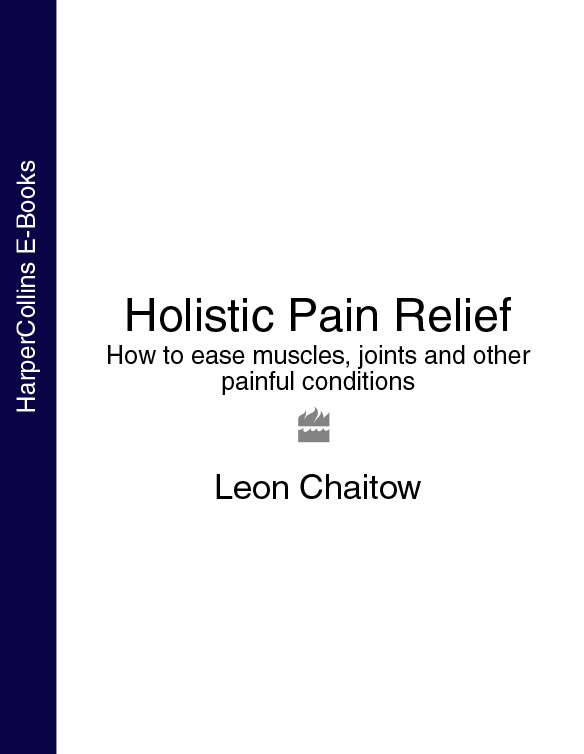
For Carol and Irwin with love.
Pain, a universal symptom, is part of everyones life experience. Yet we are taught so little about the nature, quality and purpose of pain. For many, physical pain can become mental pain and lead to a constant and chronic state of distress and despair. Because of its universality, methods for dealing with pain abound. For many in the West, taking two aspirin has become the immediate and all too frequent remedy. Leon Chaitow has described clearly and practically a wide range of approaches to pain which can be easily used by the lay public and professionals alike, for both acute and chronic conditions.
The explanations give allow the reader to understand the nature and significance of pain, often a very effective way of managing pain. It is this holistic approach to pain which makes this book so readable.
Acute pain (short and sharp) is often a danger warning which, if ignored, can lead to injury, and it may also be a reminder that you have been overdoing things, and that you need to rest and recover. In this capacity acute pain is usually useful even vital as a protective mechanism. On the other hand, chronic pain (long continued) does not seem to offer any clear advantage and is very often, and in most senses of the word, useless.
It would, however, be wrong to try to deal with chronic pain without understanding its cause, even though it may not be possible to remove the cause. Having established this, attention can be focused on the pain itself in an effort to modify, reduce, calm or ease it. Left untreated chronic pain can rapidly trigger physical and emotional problems.
About one person in every three suffers from some degree of chronic pain, and one in five will be partially or totally disabled by this during some period of their lives statistics which have made the artificial removal of pain by medication an enormous industry. Fortunately, though, non-drug methods of pain relief are also available, and some come from inside our bodies.
A cut heals and a broken bone mends without outside help (other than the obvious first-aid measures), so we should not be too surprised to find that a provision has also been made within our bodies for the easing of pain. This is by the production of endorphins and enkephalins (opiate-like pain-killing substances produced by the brain), as well as by alterations in our psychological behaviour. Many of the self-help methods used against pain, as well as treatments given to reduce its intensity, depend for their success on the release of these natural substances and on altering the way pain is transmitted to the brain.
When additional help is needed we are fortunate that variety is not lacking in the ways of treating and self-treating pain. We are almost spoiled for choice with a confusing array of chemical (medication by drugs, herbs or homoeopathic remedies), physical, electrical, electromagnetic and psychological means, as well as some extraordinary and apparently esoteric methods, all claiming success rates and asking to be tried.
The choice of the method or methods most likely to be helpful and effective in a particular case is best left to qualified practitioners, but sadly many are trained to use only one or at most a couple of systems and means of pain control, and they may be ignorant of, or prejudiced against, other methods. This is why specialist pain clinics which offer a wide range of approaches and techniques, performed by a variety of therapists, are the ideal places to look for help if you are suffering from chronic pain.
No single method or combination of methods can be said to always work, and often any of several choices can be equally successful, so trial and error is sometimes the only way to discover what is best.
Many experts believe that the nature of pain can best be understood by looking at its physical side concentrating on the nervous system while others emphasize the importance of its emotional and psychological characteristics. The truth is that both physical and psychological elements are usually intimately combined in most cases of chronic pain, and both usually require attention when dealing with long-term pain.
The experience of many thousands of therapists and researchers is that when a person suffering pain understands the causes, nature, mechanism and role of pain, a vital step has been taken in the successful handling of the problem. An added bonus comes if, as well as understanding it, the sufferer can acquire at least some ability to control aspects of the pain.
For example, there are many forms of headache which can be successfully treated by:
medication (herbal such as with feverfew; or by use of an appropriate drug)
acupuncture (which has a high success rate)
osteopathic or chiropractic treatment of the neck and head
relaxation exercises or use of biofeedback
alterations of diet if allergy, sensitivity or toxicity were the cause of the headache
postural re-education if habits of posture prove to be the underlying cause
So, which of these is the correct treatment? The ones which deal with both cause and symptom would be first choice, but, if no cause could be found, the one(s) which did the least harm in terms of side-effects, and which allowed the sufferer some degree of control over symptoms, would be best.
Both understanding and control are extremely important in helping to deal with chronic pain. The opinion of many experts is that there is almost certainly a need for a combination of both psychological (coming to terms with it; learning to control aspects of it; understanding it) and physical elements (in their broadest sense, including the use of anything from medication to acupuncture or manipulative strategies) in the successful handling of most chronic and stubborn pain problems.
Central to what is done to and for a person in pain is the need for that person to start to take some degree of control of the situation, to feel empowered to influence the processes at work and not to feel themselves to be a mere object, simply the helpless recipient of other peoples efforts. Self-help measures are therefore very important in this process, although they should not just be picked randomly but rather as part of a total approach to sufferers and their problems.
This means that any self-help method should work together with whatever help is being offered professionally. This is true whether self-help involves learning to use simple hydrotherapy measures such as hot and cold compresses, or ice massage or performing special stretching exercises, doing deep relaxation exercises, using electrical pain relieving machines such as TENS (transcutaneous electrical nerve stimulation), or anything else which helps to modify pain and which does no harm.
Fortunately for us, pain usually lasts only a short time, leaving nothing but a memory of its presence. Even more fortunately we dont retain an actual recording of the intensity of the pain we have experienced. However, the memory that it happened can help us not to do certain things again, or to do them more carefully next time.
An army of people, though, can testify to the fact that pain is not always merely a short-lived and useful warning, and in order to deal effectively with that sort of pain we need to know more about some of its unusual and sometimes confusing features.
Font size:
Interval:
Bookmark:
Similar books «Holistic Pain Relief»
Look at similar books to Holistic Pain Relief. We have selected literature similar in name and meaning in the hope of providing readers with more options to find new, interesting, not yet read works.
Discussion, reviews of the book Holistic Pain Relief and just readers' own opinions. Leave your comments, write what you think about the work, its meaning or the main characters. Specify what exactly you liked and what you didn't like, and why you think so.

